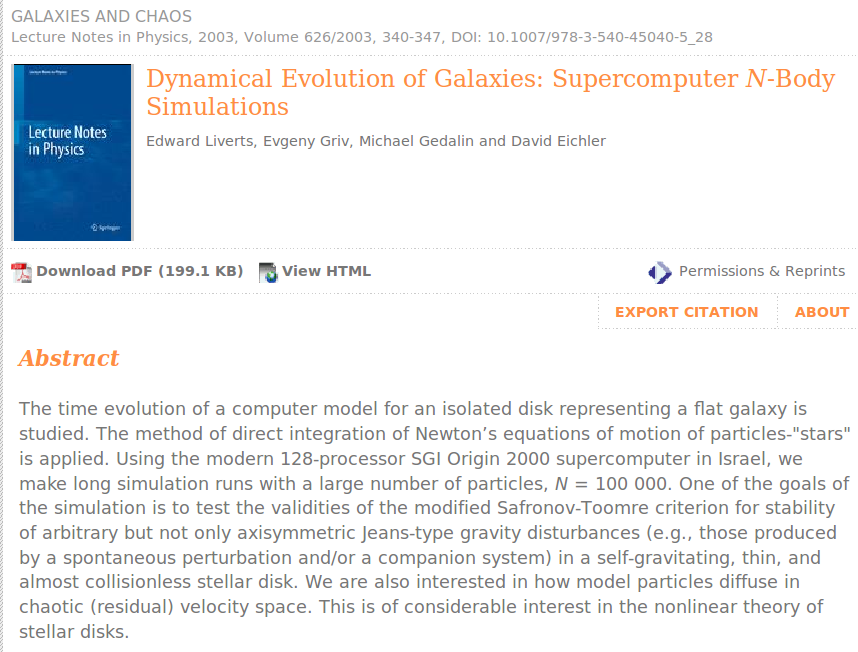
 Copyright © Michael Richmond.
This work is licensed under a Creative Commons License.
Copyright © Michael Richmond.
This work is licensed under a Creative Commons License.
You are working on problems that involve the gravitational forces between N = 2, or 3, or maybe 10, objects. As you are probably learning, the time required to perform all the calculations increases quickly with N.
Q: If a simulation of N = 10 objects takes 1 hour
on a computer, how long will a similar simulation
of N = 20 objects take?
A: 4 hours
In fact, the number of direct calculations will rise as N2.
Now, galaxies are big collections of stars. Really big. Really, really, really big.
Q: If a simulation of N = 10 objects takes 1 hour
on a computer, how long will a similar simulation
of N = 10^9 objects take?
A: 10^16 hours or approx 90,000 years
And yet, some scientists do claim to be able to simulate the motions of stars in galaxies.
How do they do it?
One way to handle the gravitational interactions of very large numbers of objects is to focus on the large-scale forces and ignore -- or pay less attention -- to the small-scale forces.
Here's the zero-th order version of this method:
The mass of the Milky Way is about 1011 solar masses, and it is arranged in a roughly spherical shape, with the highest density near the center. So, let's pretend that all the mass M is concentrated at a point in the very center.
Well, that's easy: the force on an object of mass m at a radial distance r is simply

You can compute the motions of tens of thousands of objects with a force law which is this simple! Of course, their motions don't look very much like those of real stars in a real galaxy.
So, let's look at the first-order approach, which is more sophisticated.
The mass of the Milky Way is about 1011 solar masses, and it is arranged in a roughly spherical shape; however, the mass is not very concentrated to the center, so there is plenty of mass far from the center. Let's pretend that the density is spherically symmetric, and follows some simple relationship with radius.
So, for example, we could pretend that the density is

In order to compute the gravitational force on a star at some radial distance r from the center, we

That would do a better job of reproducing the motions of stars in real galaxies -- depending on the exact values in the density relationship, we could get circular velocities which rise with radius out to some point.
But one of the distinguishing characteristics of many galaxies, our own Milky Way among them, is their relative flatness:

In order to deal with this real-life complication, we need to devise a more sophisticated approach. Consider the following multi-step technique:

This sort of technique will yield forces which are accurate on the large scales -- they will reflect well the forces on the Sun due to the conglomeration of billions of stars in the nucleus of a spiral galaxy -- but not on the small scales -- they will fail to account for the force of a rogue star which happens to fly through the solar system. Why? Because we generally use a very coarse grid to sample the density of matter.
For example, suppose we build a grid which has 1000 x 1000 x 1000 points in the X and Y and Z directions, and arrange it so that the entire Milky Way galaxy just fits inside. The diameter of the Milky Way is very roughly 100 kiloparsecs, so the width of each grid point will be

The distance to the nearest star system, Alpha Centauri, is about 1 parsec. Within a distance of 100 parsecs, there are roughly 200,000 stars (based on the incomplete count of 3803 stars in in this catalog of stars within 25 parsecs of the Sun. All these hundreds of thousands of real stars are smushed together into a single lump and placed at the center of the grid point.
Doesn't sound very accurate, does it? Well, sometimes, it's the best one can do.
 Copyright © Michael Richmond.
This work is licensed under a Creative Commons License.
Copyright © Michael Richmond.
This work is licensed under a Creative Commons License.